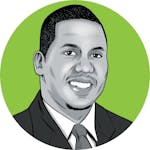The list of "Minnesota's Top Paid Executives" is the whitest thing the Star Tribune compiles each year.
If you're searching for any BIPOC folks or women on that list of 50 executives, ranked according to their annual compensation, well, good luck. The list is always very white and male.
It's John Mayer concert white. It's everybody's-singing-"Sweet Caroline"-at-the-party-for-some-reason white. It's fresh snowfall at Buck Hill white.
Sometimes, the only way to handle disparities, when you're Black, is to laugh at the overt imagery that demonstrates where you stand in this place socially, culturally and economically. It's no laughing matter, though.
The list is a reminder that the best way — maybe the only way — to secure any grand position of influence or authority in Minnesota is to be a white guy. There are 41 of them on the list. There are middle-aged white men on the list. There are younger white men on the list, too. There are white men with beards. And white men with mustaches. There are white men with a lot of hair and there are white men without any hair at all.
Not one Black face on that list and only a handful of women.
And these are just Minnesota's public companies.
I know multiple BIPOC folks who left Minnesota in recent years because they never saw a path to progress in their respective fields. That's why that image — the reality — of who can hold power here is so daunting and discouraging.
I also understand that it's a microcosm of America.
The wealth gap is widely researched.
Per the Federal Reserve website: "Looking at the population as a whole, White households hold 86.8% of overall wealth in the country according to the 2019 SCF [Survey of Consumer Finances], though they account for only 68.1% of the households in the survey. By comparison, Black and Hispanic households hold only 2.9% and 2.8% of wealth, respectively, while accounting for 15.6% and 10.9% of the US population respectively, reflecting the fact that wealth is disproportionately skewed towards White households. In fact, under racial equality, Black households would hold over 5 times the amount of wealth they currently do, and Hispanic households would hold nearly 4 times as much."
But, as the Star Tribune's executive list also illustrates, women — especially BIPOC women — are impacted too. From the Harvard Gazette: "In the United States, women who work year-round earn somewhere near 82 cents for every dollar earned by men — but they only own about 32 cents for every dollar of wealth owned by their male counterparts. Both of these gaps are far more acute for Black and Latina women."
I look at the Star Tribune's top paid executive list each year to validate my doubts about Minnesota's belief in the value of diversifying the corporate culture at its top businesses. I also look at that list to reflect on all of the empty promises that followed George Floyd's murder.
In the years that followed, I joined a multitude of BIPOC folks in the Twin Cities and beyond who were asked to speak to predominantly white organizations and corporations about diversity. I noticed similarities between those groups, some of whom were led by individuals on the Star Tribune's list, and their ambitions around diversity, equity and inclusion.
They all loved lists.
"1,289 Ways That We'll Fight Racism at Corporation X."
Huh? You don't have a corporate culture that reflects and embraces true diversity at all but you're going to complete a sizable list of tasks in a year or two? OK.
Those lists were often about making a public display, not a corporatewide commitment to change. The intentions were admirable, in some cases, and often compiled by empathetic individuals.
But they were mostly unrealistic because they would demand upheavals and changes in the way that local companies do business. And that was never the goal.
The top paid executives list proves as much.
Across America, diversity, equity and inclusion professionals have been terminated or reassigned, as recognition for DEI efforts became more important than a real deviation from the status quo.
And that's why these lists all look the same every year.
If these companies, which are mostly led by white men, continue to minimize the impact of women and BIPOC folks within their ranks — and refuse to give them a seat at the table — then they'll never see real change. And more capable BIPOC folks and women will leave Minnesota to chase opportunities elsewhere.
That's why I'd like to ask the Star Tribune to create a new list, with the participation of the local corporate community: Let's publish a list of the most influential women and BIPOC professionals at these companies and specify their exact roles — in their own words. Let's challenge these corporations to prove that they're doing more than creating, "How Can We Be More Antiracist?" lists instead of granting power to marginalized talent within their walls.
If they are doing that work, maybe the executive lists will change in the future.
Because right now, I'm not sure what's whiter: the list of top CEOs in Minnesota or an episode of "Friends."
Myron Medcalf is a local columnist for Star Tribune and recipient of the 2022 Society of Professional Journalists Sigma Delta Chi Award for general column writing.

Medcalf: Sen. Mitchell case reveals grace gap for the powerless

Medcalf: Exonerated of murder, author will speak at our Minneapolis book club about 'life and freedom'
Medcalf: Will plans to restore St. Paul's Rondo replace what was stolen?
Medcalf: Young adults' demand for work-life balance offers lessons for us all


